Reclaimed wood imparts the look of centuries-old boards. Dmitry Fisher/Fotolia.com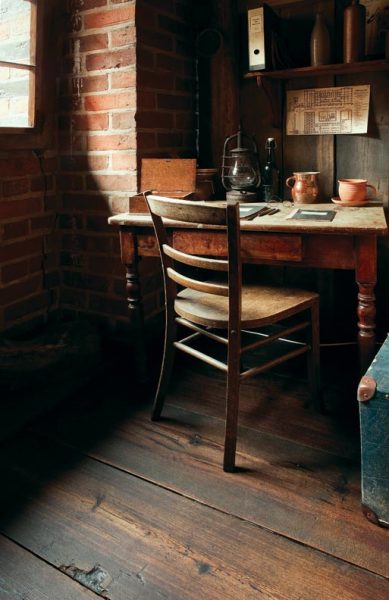
When envisioning historic interiors, many people picture rooms fitted with expanses of gleaming wooden floors embellished with oriental rugs. This perception of the past is only partly accurate—in truth, polished hardwood floors (and room-size oriental carpets) were not commonplace until the late 19th century. Before that time, wood was indeed the predominant material used in flooring, but its appearance was much humbler than you might expect.
The history of wood flooring begins in colonial America when the first floors were wide, thick planks cut from the continent’s abundant old-growth forests. Because of the trees’ age and massive diameter, the desirable heartwood was extremely tight-grained, making the lumber harder and more durable than the relatively immature wood of the same species that is harvested today.
Converting the timber into usable lumber was an arduous process; the introduction of the circular saw was decades away, and the predominant method available to create dimensional boards was to pit-saw the logs into planks. This required two men: One stood in a pit beneath a huge log that had been squared with hand tools, while the other perched atop it. Working together, they pushed and pulled at opposite ends of a long-bladed saw, carefully following chalk lines that indicated the direction of the cut. These rough-sawn planks were finished with plain, squared edges; laid side by side; and face-nailed into the floor joists. The lumber was often left bare and was eventually burnished by years of use.
Early wood floors, like this one at the 1805 Woodlawn Plantation, were typically untreated. Jasper Silver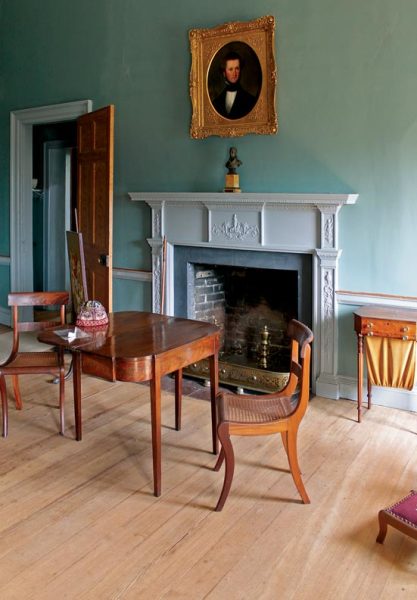
Although the wide floorboards were butted together on installation, gaps would open between them due to fluctuations in temperature and humidity, allowing damp, cold air to pass into the living area from the basement. Small objects were also prone to falling through these gaps, disappearing into the depths below. This was eventually rectified by ship-lapping the boards, a simple technique wherein the long edge of the plank was planed with an “L” profile that interlocked with the adjacent board. Now, when the wood shrank and drew apart, the gap was concealed by the edge of the adjacent board.
Decorative Flourishes
As decoratively painted interiors became popular in the 18th century, this technique was applied to wood floors, too. They could be monochromatic or fancifully ornamented, with geometrics such as checkerboard patterns a perennial favorite. The use of stain and varnish, however—as is so often applied today by homeowners seeking a warm, honey-colored patina—was relatively uncommon; average 18th- or early 19th-century homeowners wouldn’t recognize a shiny floor in their post-and-beam homes.
Decorative painting became all the rage for floors in the 18th century. Sandy Agrafiotis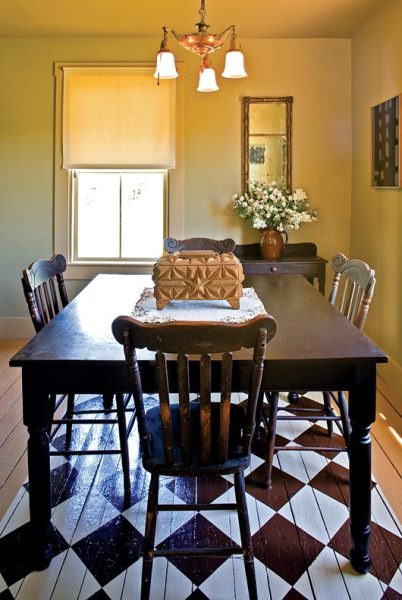
During the first two-thirds of the 19th century, wooden floors that weren’t painted were intended to be covered; they were made of structural, not finish-grade, lumber, so knots and other blemishes abounded. The then-recent invention of the power loom meant that carpet was becoming more affordable to the growing middle class: stylish flat-woven carpets called Venetians and Ingrains, and pile carpets known as Wilton, Brussels, and Axminster. All were woven in 27″- or 36″-wide strips, hand-sewn together, and tacked down around the perimeter of the room. (Yes, wall-to-wall carpet wasn’t a mid-century phenomenon; it actually dates to the late 18th century.)
Before the mid-19th century, there were few finished hardwood floors, but the wealthiest of homes might sport hardwood parquet in certain public rooms. Parquet is the method of arranging pieces of wood in geometric patterns (herringbone and diamond being the most common) and affixing the pieces to the subfloor with tiny nails. This process was hugely labor-intensive, as each piece had to be cut and fitted by hand. To smooth the surfaces of the wood to a consistent level, the entire floor was scraped and planed by hand, then varnished and/or waxed.
Wood Flooring Finished Boards
Another benefit of the Industrial Revolution was the invention of steam-driven woodworking machinery that permitted the mass production of finished boards. Now, dimensional lumber could be milled in fixed lengths and widths, which expedited the installation of floors and gave them a far more finished appearance.
Parquet borders were popular for achieving a high-end look; similar treatments are available from modern manufacturers. Jasper Silver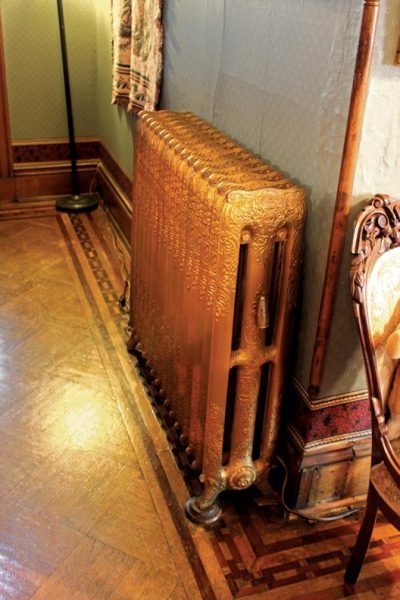
Along with this technology appeared the process for molding tongue-and-groove floorboards. Tongue-and-groove molding is a precise method of joining boards together along their lengths by fitting a protruding “tongue” on one board into a channel cut on the adjoining board. With tongue-and-groove installation, the nails are driven through the tongue, forcing the boards together; this also conceals the nail holes, creating an unmarred surface. The interlocking boards also were much more resistant to upward movement, which minimized irregular edges sticking up in the path of passing feet. Structural-grade tongue-and-groove floorboards, typically pine or lower-grade oak, were typically a uniform 6″ to 8″ in width, much narrower than the wider pit-sawn planks of the 17th and 18th centuries.
Shiny & New
It wasn’t until the late 19th century that average Americans began to have what we now think of as polished hardwood floors in their homes. Appearing first in public rooms and kitchens, finished hardwood flooring quickly spread to bedrooms and other private areas.
Along with the technology that permitted its mass production, fashion and health concerns created an increasing demand for hardwood floors. The revival of medievalism, as promoted by Charles Locke Eastlake and William Morris, and the concurrent fascination with Orientalism and the decorative arts from Asia and the Middle East, were an austere departure from the plush neoclassical, Renaissance, and Rococo influences that had dominated popular taste for the past century.
Reclaimed boards of varied tones call to mind the late 19th-century practice of alternating species within the same floor. Courtesy of Chestnut Specialists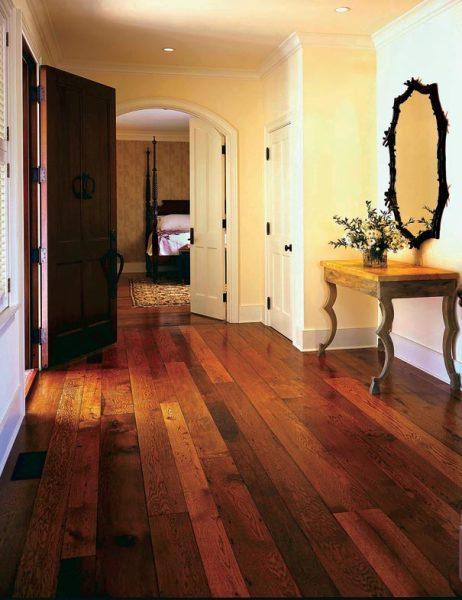
Eastlake, in his widely read book Hints on Household Taste, was an influential proponent of area rugs laid upon hardwood floors. It was believed to be healthier, as rugs, unlike tacked-down carpets, could be taken out and beaten. Eastlake also promoted the use of hardwood parquet borders around the perimeter of the room, with less-expensive softwood, covered by carpet, in the center. This gave the appearance of a high-end floor with a much lower price tag, since homeowners only shelled out for the fancy border. Carpet manufacturers capitalized on this trend, too, by creating borders for their goods and emulating oriental carpet patterns in their lines, allowing them to obtain the look of expensive, hand-woven imported carpets for a fraction of the cost.
The hardwood floors of this period were typically white oak, chestnut, maple, or black walnut milled into 2″- to 3″-wide boards. Maple was popular in kitchens due to its strength and resilience, since it had no open pores that might absorb spills. Around the 1870s and 1880s, it wasn’t unusual to find floors in public rooms laid in alternating strips of walnut and maple. Toward the turn of the century, fir became the wood of choice, first in kitchens, but then creeping into other rooms.
Using wide-plank flooring can help a new addition blend with an old house. Courtesy of Hull Forest Products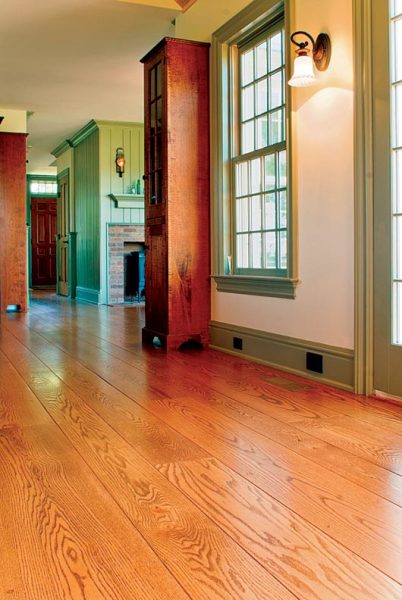
Installation was still much more laborious than it is today; before the advent of the power sander, wood floors had to be scraped smooth by hand. These were finished with coats of orange shellac and then waxed. Interestingly, this was considered a maintenance finish; when marred or worn, the shellac was scrubbed off and then reapplied—a very different approach than at the turn of the century and later, when varnished (and later, polyurethaned) surfaces had to be sanded down to the bare wood. Wood floors were not typically stained; the vintage ones you see have darkened varnish.
Hardwood floors remained popular into the mid-20th century, at which point manufactured materials became synonymous with modernism, and wood fell from favor. But the Victorian and Craftsman revivals of the late 20th century saw a renewed interest in hardwood flooring, along with the use of reclaimed lumber to replicate early floors. Regardless of the whims of fashion, wood floors have retained their enduring appeal, particularly for those dwelling in vintage homes.







